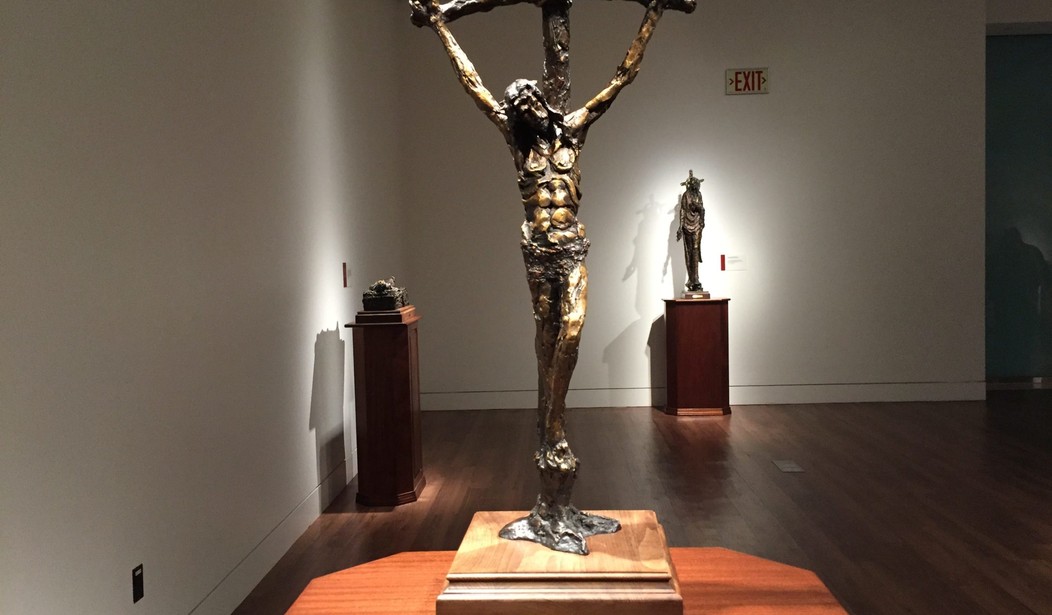On Friday, Christians across the world commemorate the Crucifixion of Jesus Christ. The holiday is known as “Good Friday” because Jesus’s death paid the penalty for sins — and paved the way for His Resurrection, His victory over death. The Museum of the Bible did not open any exhibitions about the historicity of the Death and Resurrection of Christ, but it did present an artistic rendering of the “Stations of the Cross.”
Christians across the world — and Roman Catholics in particular — remember the events of Good Friday broken into 14 separate episodes, known as the “Stations of the Cross.” The vast majority of these stations come from the Gospel accounts of Matthew, Mark, Luke, and John.
According to the Bible and church tradition, Jesus was condemned to death (1), carried His cross (2), fell to the ground on the way (3, 7, 9), meets his mother (4), received help from Simon of Cyrene (5), had his bloody and sweaty face wiped by Veronica (6), met the women of Jerusalem (8), was stripped naked (10), was nailed to the cross (11), and died on the cross (12). The final two stages involve His body being taken down from the cross (13), and His being laid in the tomb of Joseph of Arimathea (14).
“I think on some level every sculptor has a dream of doing the Stations of the Cross,” Gib Singleton, the sculptor behind the Bible Museum’s exhibit, said. “It’s probably the most spiritual subject any artist can deal with. Everything important in the human story is right there — life, death, courage, compassion, love, betrayal, redemption.”
While Singleton took some license with his sculptures, each artwork arguably captured the spirit of the corresponding Station of the Cross. Below are PJ Media’s picks of the ten most arresting sculptures in the exhibit.
1. Behold your king.
In this sculpture, corresponding to the second station, Jesus carries His cross. His emaciated face and body speak of the pain and exhaustion He had gone through.
Jesus was scourged by Roman soldiers before being forced to carry His cross to Golgotha, a humiliating walk of shame figuring prominently in the torturous practice of a Roman crucifixion. Mel Gibson’s “The Passion of the Christ” displayed just how painful this scourging would have been, and why carrying the cross afterword would have been a horrendous ordeal. Jesus would have been physically exhausted and in tremendous pain.
2. Wine-soaked robe.
Singleton’s third sculpture, corresponding to the third station, shows Jesus having fallen to the ground, with a Roman soldier whipping Him. Jesus pitifully raises His hand in protest, but the soldier has no mercy.
3. Veronica’s vision.
According to Roman Catholic tradition, a woman named Veronica came up to Jesus during His procession, and wiped his bloody face with her veil. In Singleton’s sculpture, Jesus rests on a stump with the cross behind Him. Above Him, Veronica’s veil — with the powerful imprint of Jesus’s face — hangs from the cross, foretelling Jesus’s crucifixion.
Singleton may have decided to remove Veronica from the sculpture because she is not recorded in the Bible. Removing her only emphasized her veil and her powerful act of giving Jesus aid during His most trying hours.
4. Fallen lamb.
Singleton’s seventh sculpture, like the seventh station, displays Jesus’s second fall on the long road to Golgotha. The artistic presentation of Jesus’s slumped body and His emaciated cross conveys the utter weakness of the Savior as He stumbles to His death. This humility (captured in Philippians 2) reaches its apex in the crucifixion, and Singleton’s design captured it well.
5. Scourging.
The tenth Station of the Cross commemorates the Roman soldiers stripping Jesus of His clothes right before nailing Him to the cross. Singleton’s sculpture does not display this humiliating stripping, but instead portrays a Roman soldier whipping Jesus and placing the crown of thorns on His head. This scene invoked the mockery Jesus received from Roman soldiers before He was condemned to death, before the first station.
The humiliation of Jesus being stripped naked has been compared to the sexual assault revealed by the #MeToo movement, and not without reason. In this sculpture, the Roman soldier’s prying face and Jesus’ look of shame echo the abuse Jesus received before His torturous execution.
6. Be forsaken.
The eleventh Station of the Cross recollects the moment when Roman soldiers pounded the nails into Christ’s hands and feet. Singleton’s artworks captures the brutality of this heinous act, and Jesus’s cries in agony.
The title of his work, “be forsaken,” is a reference to Jesus’s words on the cross, “Eli, Eli, lema sabachthani?” or “my God, my God, why have you forsaken me?” (Matthew 27:46). Jesus almost always refers to God as “Father” or “Abba” (a close word for father in Aramaic), but in this case, He expresses His alienation from God, even while He is (according to Christian doctrine) a Person of God Himself.
7. Crucifixion.
The twelfth station, Jesus’ Death on the cross, captures the final moment when God Himself died, satisfying the wrath of God. Singleton’s sculpture manages to convey the emaciation of Jesus’s body while presenting the Christ as glorious even in this moment of death. While the sculpture emphasizes Jesus’s muscles, the shapes are just out of place and slightly misshapen, revealing the pain and disfiguration of torture.
8. Pieta.
Countless artists have captured the Virgin Mary’s moment of utter grief in holding the body of her dead Son, but Singleton almost entirely hides the mother of Christ, focusing instead on Jesus’s lifeless body. The drooping head, in particular, perfectly captures the moment of peace after the defeat of death.
9. Entombed.
The final Station of the Cross, Jesus being laid in the tomb, often emphasizes the cave in which He was buried, and the stone being rolled in front of it. Singleton, however, emphasizes the body itself, and presented it like a sarcophagus — evoking the sarcophagi of Egyptian pharaohs.
According to Christian doctrine, Jesus Christ is the ultimate king, and this presentation of His glory in death helps capture this theme.
10. Redemption.
Unlike the Stations of the Cross, Singleton did not end his sculptures with the death of Christ. His final artwork, “Redemption,” shows a risen Jesus with a halo-cross on His head, as He removes the crown of thorns. His left hand reveals the stigmata, the wounds of the crucifixion, showing that He really did die and that this sculpture shows Him risen from the dead.
By concluding with this sculpture, Singleton and the Bible Museum point to the Resurrection, the central historical event of the Christian faith.
In a statement about the museum, spokeswoman Heather Cirmo emphasized that “the museum is non-sectarian and takes great care not to elevate one religion over another.” This exhibit did not do that, but it did capture the deep spiritual meaning behind the events of Good Friday and Easter Sunday.
Anyone in the Washington, D.C. area would be well-served by attending the Bible Museum and going through the “Stations of the Cross” exhibit on Good Friday or any other time.
While some at PJ Media have criticized the museum as overly commercial and superficial, this exhibit and others present the context and impact of the Bible in the heart of America’s capital. People of all religions and none should attend the museum, as the Bible’s use and abuse has had a tremendous impact on history and the modern world.



















Join the conversation as a VIP Member